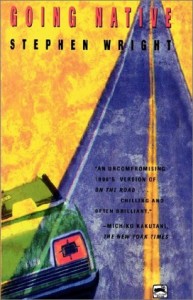 Wright, Stephen (994). Going Native. New York: Dell Publishing.
Wright, Stephen (994). Going Native. New York: Dell Publishing.
Writing For the Sake of Writing
This widely praised novel is more like a collection of very loosely connected short stories. The writing is interesting, some of the sentences hallucinatory. That’s the joy of reading the book. However, there is no traditional plot, no significant character development, and no particular insights are revealed. It is just a series of almost unrelated scenes and characters.
Should it be read then as an anthology of stories? That doesn’t work well, either, because the chapters/stories themselves lack dramatic tension and insight into characters, so as stories, they don’t work well. A recurring theme in the book is allusion to horror movies. Characters describe horror movies they have seen, or scenes are staged like scenes from horror movies, and maybe that’s why the stories and scenes seem pointless, as horror movies themselves are. So maybe the book is supposed to be a high-concept parody of the horror genre. But if that’s the game, it loses for being repetitive, unfunny, uninsightful and, above all, not horrifying.
The writing itself is interesting, original, and well-observed. Here are some random samples:
At their backs there’s a flash and a sudden whoosh, a beat of gigantic wings; they swivel in their seats to the unnerving spectacle of a column of flame rearing up angrily into the dim air. ‘Oh look,’ remarks Rho, ‘Wylie’s got the fire going.’ The daiquiri pitcher is emptied and refilled and emptied again. The citronella candles are lit. Mr. Freleng, the retired electrician next door, totters out to adjust his hose, faithful attendant to the abiding needs of the lawn god. He behaves as if he were alone, blind and deaf to the balcony audience spellbound by each fussy exertion. Upstairs the children sleep at last. Daphne gets paid and goes home. A small dark bat appears, flutters anxiously through the soft twilight, a flimsy prop on ineptly managed wires.” (pp 24-25)
““’Listen, Woodstock, the picture, ever see it?’
‘I don’t know. I guess. Sure.’
’Well, remember the scene where everybody’s romping bare-assed in the mud? I’m the guy on the left with the beard and the big dick. God, the times we had…’ He waggled his big head in disbelief. ‘A planet of wonders. Like to visit it again someday before I die.’ He looked over at his listener. And now I’m immortalized in celluloid, how about that?’” (p. 73).
The enduring topics are stifling everydayness, punctuated by sex, violence, and drugs, told in interesting and complex sentences. In the end, there is a hint that a certain 1960’s Ford is a clue that allows you to reconstruct a chronology of one or more characters, but why would you?
Is this a novel? Call me old-fashioned, but I say it is merely writing for the sake of writing, not for the sake of traditional storytelling or for Aristotelian exposition of human relationships to God/fate/destiny. Many readers might find reading the book an enjoyable experience, as long as they have their expectations set appropriately.
